Chapter 4. Multi-tasking
4.0.0.0.1 Welcome
Think Like a Scientist
Multi-tasking
By:
Susan A. Nolan, Seton Hall University
Sandra E. Hockenbury
With the assistance of Scott Cohn, Western State Colorado University
REFERENCES
Alicke, Mark D. & Govorun, Oleya. (2005). The better-than-average effect. Mark D. Alicke; David A. Dunning; & Joachim I. Krueger (Eds.). The self in social judgment. Studies in self and identity (85–106). New York: Psychology Press.
Finley, Jason R.; Benjamin, Aaron S.; & McCarley, Jason S. (2014). Metacognition of multitasking: How well do we predict the costs of divided attention? Journal of Experimental Psychology: Applied, 20, 158–165. doi:10.1037/xap0000010
Gaspar, John G.; Street, Whitney N.; Windsor, Matthew B.; Carbonari, Ronald; Kaczmarski, Henry; Kramer, Arthur F.; & Mathewson, Kyle E. (2014). Providing views of the driving scene to drivers’ conversation partners mitigates cell-phone-related distraction. Psychological Science, 25, 2136–2146.
Ophir, Eyal; Nass, Clifford; & Wagner, Anthony D. (2009). Cognitive control in media multitaskers. Proceedings of the National Academy of Science. 106, 15583–15587.
Sanbonmatsu, David M.; Strayer, David. L.; Medeiros-Ward, Nathan; & Watson, Jason M. (2013). Who multi-tasks and why? Multi-tasking ability, perceived multi-tasking ability, impulsivity, and sensation seeking. PLOS ONE, 8, e54402. doi:10.1371/journal.pone.0054402
Schroeder, Paul; Meyers, Mikelyn; & Kostyniuk, Lidia. (2013, April). National survey on distracted driving attitudes and behaviors – 2012. (Report No. DOT HS 811 729). Washington, DC: National Highway Traffic Safety Administration.
Strayer, David L.; Watson, Jason M.; & Drews, Frank A. (2011). Cognitive distraction while multitasking in the automobile. The Psychology of Learning and Motivation, 54, 29–54.
Watson, Jason M., & Strayer, David L. (2010). Supertaskers: Profiles in extraordinary multitasking ability. Psychonomic Bulletin and Review, 17, 479–485.
FAQ
What is Think Like a Scientist?Think Like a Scientist is a digital activity designed to help you develop your scientific thinking skills. Each activity places you in a different, real-world scenario, asking you to think critically about a specific claim. Can instructors track your progress in Think Like a Scientist? Scores from the five-question assessments at the end of each activity can be reported to your instructor. To ensure your privacy while participating in non-assessment features, which can include pseudoscientific quizzes or games, no other student response is saved or reported. How is Think Like a Scientist aligned with the APA Guidelines 2.0? The American Psychological Association’s “Guidelines for the Undergraduate Psychology Major” provides a set of learning goals for students. Think Like a Scientist addresses several of these goals, although it is specifically designed to develop skills from APA Goal 2: Scientific Inquiry and Critical Thinking. “Multi-tasking” covers many outcomes, including:
- Use scientific reasoning to interpret psychological phenomena: Describe common fallacies in thinking that impair accurate outcomes and predictions. [consider overconfidence]
- Use scientific reasoning to interpret psychological phenomena: Use psychology concepts to explain personal experiences and recognize the potential for flaws in behavioral explanations based on simplistic, personal theories. [compare personal belief and scientific findings]
4.1 Introduction
This activity invites you to test the claim that many people are good at multi-tasking. First, you’ll get a chance to see how well you can multi-task. You’ll then examine recent studies about whether most people are actually good at multi-tasking. Next, you’ll explore alternative explanations for why people believe they can multi-task well. Finally, you’ll consider the source of our belief that we’re good at multi-tasking.
4.2 Identify the Claim
1
Identify the Claim
4.2.1 Do You Multi-task?

Do you ever try to do more than one thing at the same time? Are you good at it? It’s possible you’re multi-tasking right now. Do you have other applications open on your computer? About 70 percent of people think they are better than the typical person at multi-tasking (Sanbonmatsu, 2013).
4.2.2 Multi-tasking While Driving
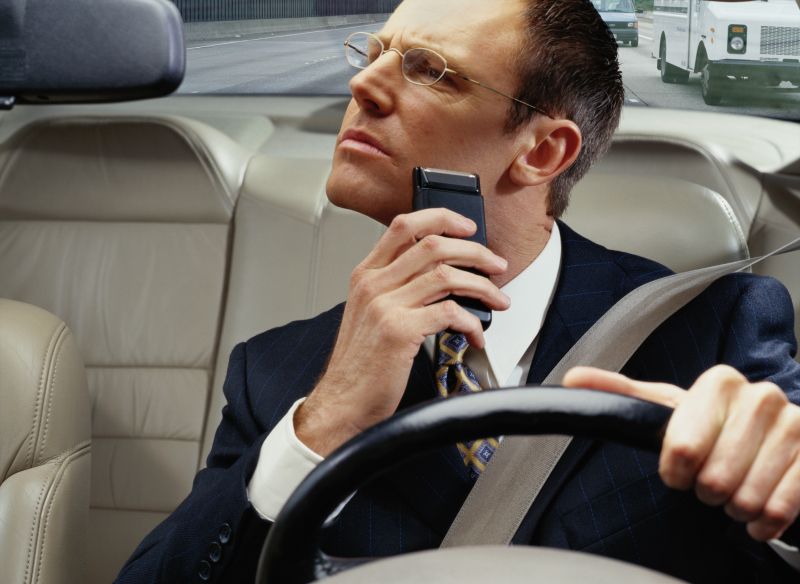
One particular type of multi-tasking has been in the news quite a bit lately—multi-tasking behind the wheel. Do you dial and drive? Or perhaps worse, text and drive? A recent National Highway Traffic Safety Administration report found that approximately half of U.S. drivers operate their vehicle while distracted (Schroeder & others, 2013). At least some of the time, drivers eat, talk on the phone, text, or read while driving. Twenty percent of people even report that they have put on makeup or shaved behind the wheel!
Most of these distracted drivers probably believe they can multi-task safely, and there are no statewide bans on most of these activities, including using cell phones while driving. Yet, most states do prohibit texting while driving, and several require the use of a hands-free device for talking on a cell phone while driving. It seems plausible that people can safely use a hands-free device to talk on a cell phone while driving, but is this true? Are we good at some kinds of multi-tasking?
4.2.3 Identify the Claim
We’ve talked about what most of us think about multi-tasking generally, as well as multi-tasking behind the wheel. Before moving on to evaluating the evidence about multi-tasking, let’s identify the claim we’ve been discussing.
Question 1.
Which of the following summarizes the claim?
| A. |
| B. |
| C. |
| D. |
4.3 Evaluate the Evidence
2
Evaluate the Evidence
4.3.1 Test Your Multi-tasking Skills
So let’s see how good you are at multi-tasking. In this activity, you will complete two tasks. The first task requires you to listen to a story and respond to the words “left” and “right” as you hear them. The second task involves exchanging text messages with another person. You’ll first attempt each task individually. Then, after you’ve tried each task, you’ll attempt both tasks at the same time. Neither task is particularly difficult, but doing both at the same time will require you to switch your attention back and forth between the two tasks.

4.3.2 Left or Right with the Wrights
In this task, listen carefully to the first half of “The Wright Family Story” while pressing the left arrow key on your keyboard (or clicking the left button on the screen) each time you hear the word “left” or the right arrow key on your keyboard (or right button on the screen) each time you hear the word “right” or “Wright.” In order for your response to be correct, you must correctly press or click either left or right within 1 second of hearing “left” or “right” or “Wright.”
Question
4.3.3 The Texting Activity
In this next activity, you will text responses into a simulated cell phone (actually just your keyboard). Like normal texting, incoming messages will appear on the screen. Then you must respond with a text message of your own. For this activity, the response you need to type will appear in red above the text window and then you must text your response immediately. To do so, simply type the exact same message in the text box using your keyboard and then click on the word “Send.” You’ll receive one point for each message you send where all the words are spelled, capitalized, and punctuated exactly like the original message.
Question
4.3.4 Time to Multi-task
Did you find the left/right task or the texting task challenging? You probably didn’t, but now try doing them both at the same time. Remember, you can use the left and right arrow keys or the left and right buttons, whichever is easier for you.
Question
4.3.5 How Good Were You at Multi-tasking?
So how did you do at multi-tasking? Were you surprised at your score when you did both tasks at the same time?
Question 2.
Which answer best describes how easy it was to multi-task in this case?
| A. |
| B. |
| C. |
| D. |
4.3.6 Multi-tasking Rates
Let’s look at some general research findings about multi-tasking and then explore one study of multi-taskers in more detail. [] Researchers estimate that just over 97% of people perform more poorly when multi-tasking than when just doing one task at a time (Watson & Strayer, 2010). Researchers found that just 2.5% of us are good at multi-tasking. These people are called supertaskers.

4.3.7 The Equivalent to Being Legally Drunk
Unfortunately, many more than 2.5% of people engage in multi-tasking, including the dangerous behavior of multi-tasking while driving. And those who frequently multi-task with media—texting while writing a paper, for example—are both less proficient at multi-tasking in general and, frighteningly for those of us on the road, more likely to multi-task while driving (Sanbonmatsu & others, 2013). How dangerous is this? In one study, researchers reported that carrying on a conversation while operating a driving simulator resulted in driving impairment equivalent to being legally drunk. This was true even for participants using hands-free devices (Strayer & others, 2011). Another study of participants using a driving simulator demonstrated the dangers of talking on the phone (Gaspar & others, 2014). A conversation on a cell phone led to more accidents while merging than driving alone. It also led to more accidents than simply talking with a passenger—because a passenger can adjust his or her behavior in response to the driving conditions.
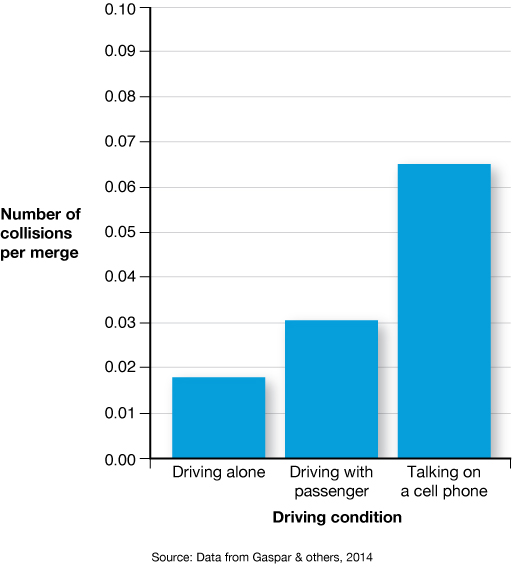
4.3.8 Studying Multi-tasking
What about multi-tasking in other situations? If you’re not risking a car crash, can multi-tasking be helpful? In order to explore the effects of multi-tasking, researchers compared people who multi-task a lot with people who rarely multi-task (Ophir & others, 2009). These two groups were determined by asking people about their behavior when “consuming media.” For example, do they use multiple devices at once or watch TV while looking at information online? Do you think of yourself as a light multi-tasker or a heavy multi-tasker when you consume media?
Question 3.
| A. |
| B. |
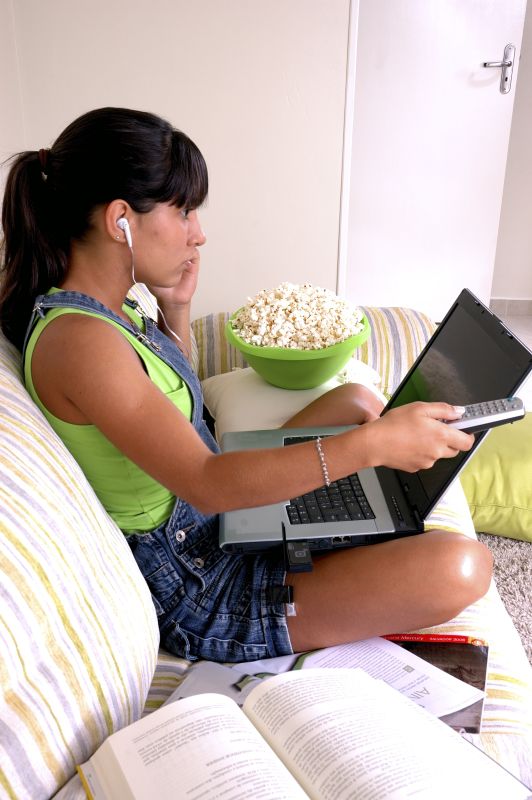

4.3.9 The Effects of Multi-tasking
The researchers asked both the light multi-taskers and the heavy multi-taskers to complete several cognitive tasks, including the one shown here. Participants see one display flashed very briefly. It’s then removed for about a second before a second version of the display is shown. The task is to identify whether either of the green bars has changed its orientation, while ignoring the orange bars, which are distractions. In the figure here, for example, the green bar on the bottom shifted from vertical to diagonal. So who do you think performed better on this task, light multi-taskers or heavy multi-taskers?
Question 4.
| A. |
| B. |
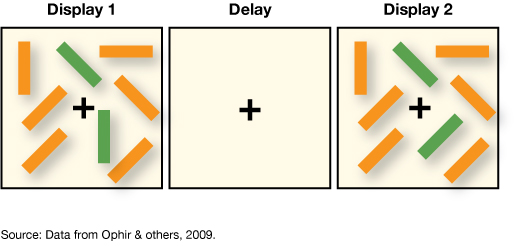
4.3.10 Multi-tasking and Cognition
You guessed the multi-taskers would perform better on this task. As you can see in this graph, on average, the light multi-taskers were better at tuning out the distraction of the six orange bars than the heavy multi-taskers were. The researchers believe this finding suggests that heavy multi-tasking makes it harder to tune out distracting information. The suggestion is that multi-tasking impairs at least some cognitive abilities. Other researchers have made similar findings (Sanbonmatsu & others, 2013). In fact, they concluded that people “who chronically multi-task are not those who are the most capable of multi-tasking effectively.”
Earlier you said that you were more of a multi-tasker. Does this finding affect how you think about your own habits?
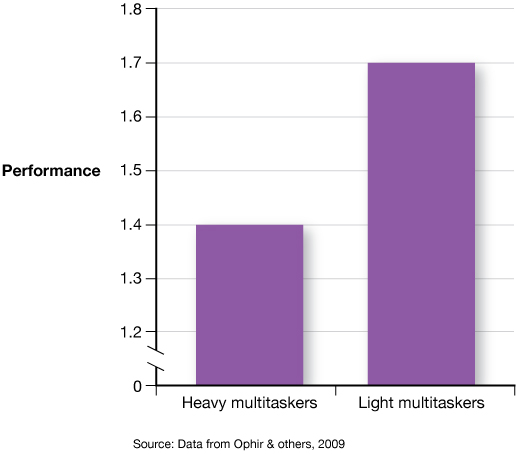
4.4 Consider Alternative Explanations
3
Consider Alternative Explanations
4.4.1 Overconfidence
All the research points to the fact that most people can’t multi-task effectively. Why not? Multi-tasking involves the division of attention—and attention is a limited resource. When you try to pay attention to more than one task at the same time, your performance on both tasks suffers (Finley & others, 2014). [] In fact, in terms of probability, there is only a 1 in 40 chance that any individual person can actually multi-task effectively. So why do most people think they are good multi-taskers? One reason is that people are often overconfident about many of their abilities in general (see Alicke & Govorun, 2005). And multi-tasking is one area in which people are overconfident (Sanbonmatsu & others, 2013). Unfortunately, this confidence is often misplaced. According to researchers, more than 70% of college students believe they are above average at multi-tasking. In actuality, people who multi-task the most tend to be the least capable at tasks requiring multi-tasking (Sanbonmatsu & others, 2013). We also learned that heavy multi-taskers tend to perform more poorly than light multi-taskers on some cognitive tasks (Gaspar & others, 2013).
Question
In the box below, provide an example from your daily life where you attempt to multi-task. Do you plan to change your multi-tasking behavior in light of the research on multi-tasking?
4.4.2 Inattentional Blindness
Here’s another explanation for why most people think they can multi-task: They don’t know what they’re missing. It’s likely that this actually leads to some of our overconfidence. If we don’t notice when we miss things, we don’t realize that we’re not as good as we think we are. Maybe you walked right past your best friend because you were too busy checking out Instagram as you crossed campus. Or maybe someone talking on the phone ran through a red light right in front of you. In many cases, people don’t realize what they missed because they were too distracted. As you learned in the chapter on consciousness, this obliviousness is called inattentional blindness. This occurs when our attention is drawn to one task, and we fail to notice important events that are clearly in our field of vision.
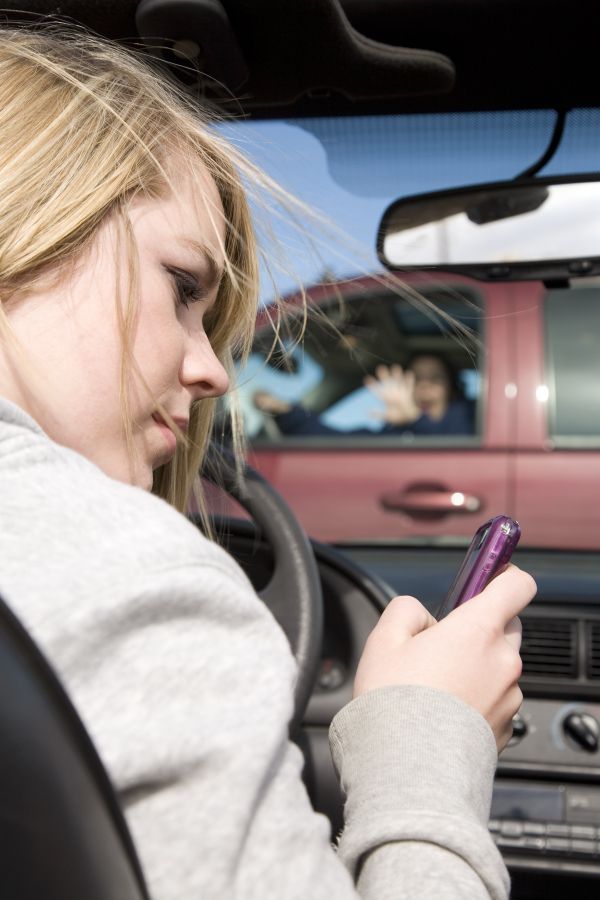
4.5 Consider the Source of the Research or Claim
4
Consider the Source of the Research or Claim
4.5.1 Personal Beliefs vs. Scientific Findings
The claim is that most people are good multi-taskers, at least in some contexts. However, it turns out that very few people can actually multi-task well, and those who multi-task often can experience negative consequences. In this case, the source of the claim is likely our personal beliefs. However, thinking like a scientist often means that we need to set aside our personal beliefs when they don’t agree with scientific findings. Ignoring the scientific research and being overconfident in our ability to multi-task can put our lives at risk and impair at least some of our cognitive abilities.

4.5.2 When Nearly Everyone Believes They Are Part of the Special 2.5%
People seem to lack an understanding about how difficult it is for the human brain to switch between two different tasks. Too many people think they are part of the special 2.5% who can multi-task effectively. Distracted drivers often fail to notice how dangerously they are driving as they also attend to something other than driving. As this video shows, people shouldn’t even try to text while doing something as simple as riding an escalator.
4.5.3 The Myth of Multi-tasking
For almost everybody, the ability to multi-task is a myth. Yet, people continue to believe they can multi-task effectively. Earlier, you wrote about an example of multi-tasking in your daily life, as well as how the research on multi-tasking has made you think about your current behavior. You said:
For most of us, multi-tasking might be wasting hours of productivity every day. The example you provided might be a good place to begin breaking the habit of trying to multi-task.
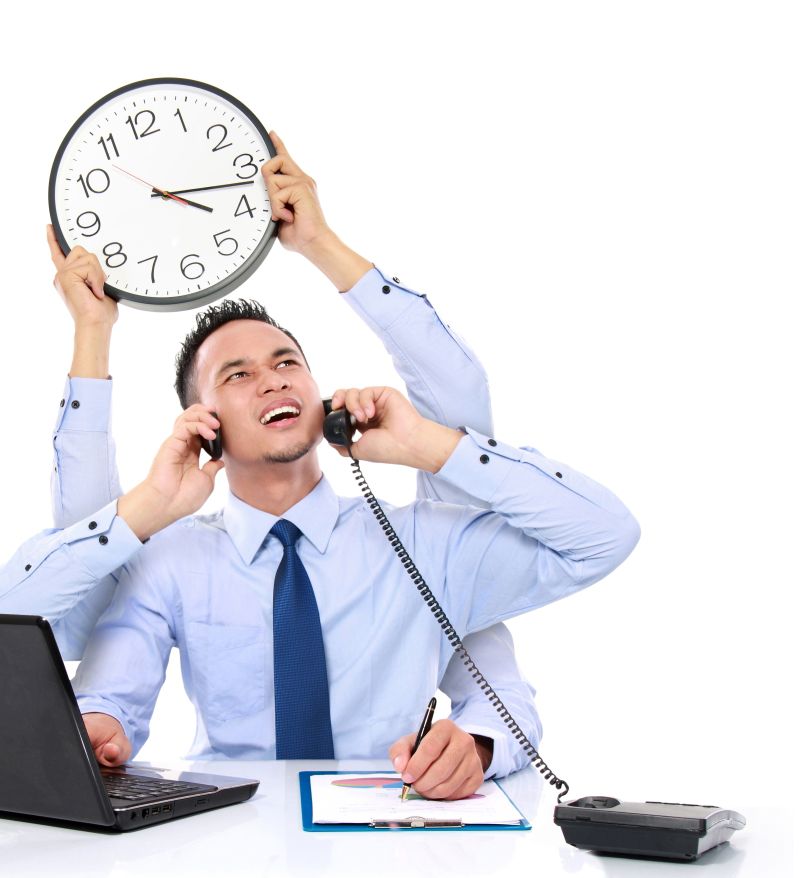
4.6 Assessment
Assessment
4.6.1 Assessment
Question
Psychological research on multi-tasking has shown that:
| A. |
| B. |
| C. |
| D. |